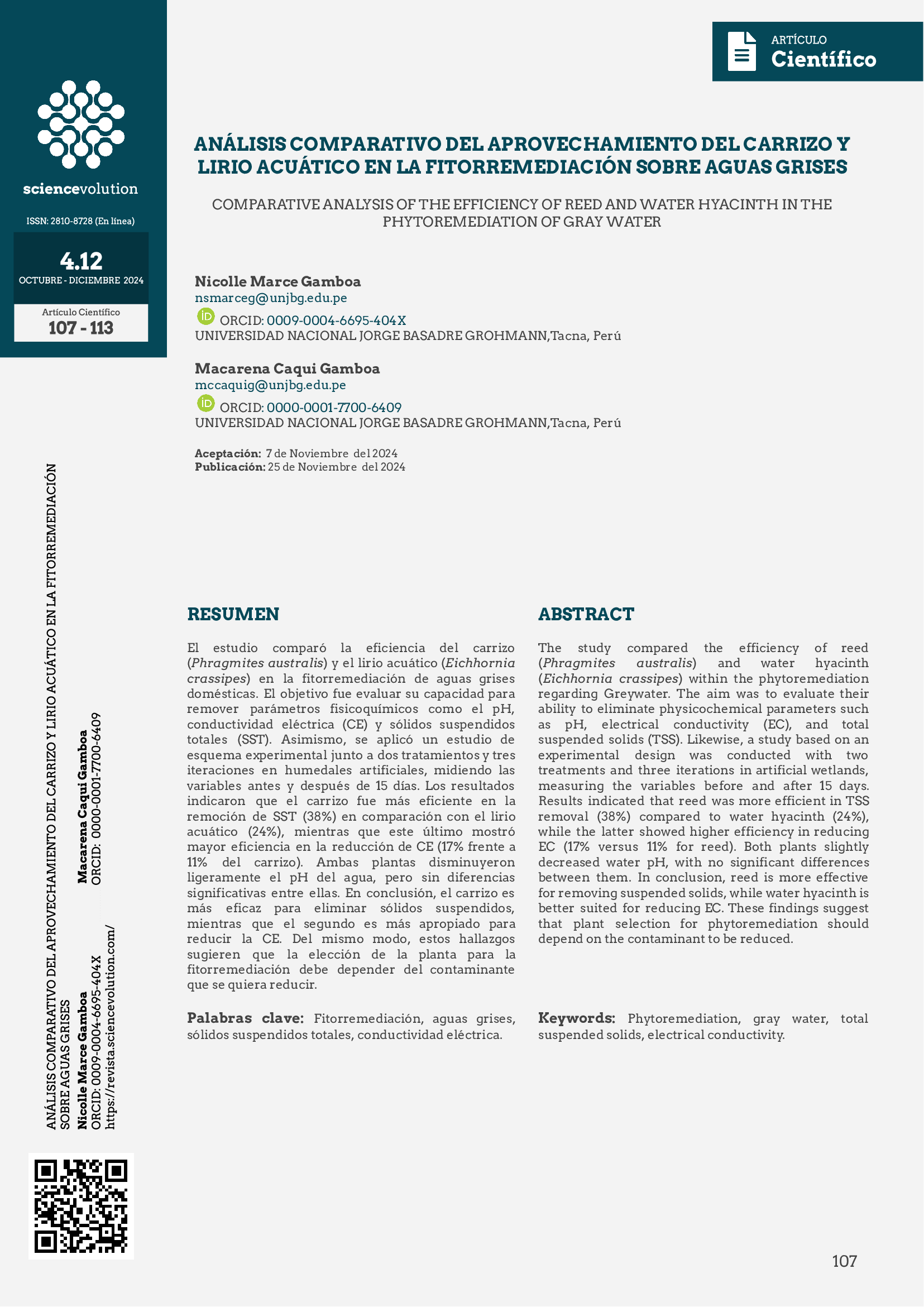Abstract
The study compared the efficiency of reed (Phragmites australis) and water hyacinth (Eichhornia crassipes) within the phytoremediation regarding Greywater. The aim was to evaluate their ability to eliminate physicochemical parameters such as pH, electrical conductivity (EC), and total suspended solids (TSS). Likewise, a study based on an experimental design was conducted with two treatments and three iterations in artificial wetlands, measuring the variables before and after 15 days. Results indicated that reed was more efficient in TSS removal (38%) compared to water hyacinth (24%), while the latter showed higher efficiency in reducing EC (17% versus 11% for reed). Both plants slightly decreased water pH, with no significant differences between them. In conclusion, reed is more effective for removing suspended solids, while water hyacinth is better suited for reducing EC. These findings suggest that plant selection for phytoremediation should depend on the contaminant to be reduced.
References
Bianchi, E., Biancalani, A., Berardi, C., Antal, A., Fibbi, D., Coppi, A., Lastrucci, L., Bussotti, N., Colzi, I., Renai, L., Scordo, C., Del Bubba, M., & Gonnelli, C. (2020). Improving the efficiency of wastewater treatment plants: Bio-removal of heavy-metals and pharmaceuticals by Azolla filiculoides and Lemna minuta. The Science of the Total Environment, 746, 141219. https://doi.org/10.1016/j.scitotenv.2020.141219
García-Valero, A., Martínez-Martínez, S., Faz, Á., Terrero, M. A., Muñoz, M. Á., Gómez-López, M. D., & Acosta, J. A. (2020). Treatment of wastewater from the tannery industry in a constructed wetland planted with phragmites australis. Agronomy, 10(2). https://doi.org/10.3390/agronomy10020176
Gonzales León, S. C. (2023). Evaluación de la capacidad de fitorremediación de Eichhornia crassipes (jacinto de agua) en efluentes con cromo de una industria curtidora del parque industrial Río Seco, Arequipa [Tesis de licenciatura, Universidad Católica Santa María]. https://hdl.handle.net/20.500.12920/13305
Karam, F., Haddad, R., Amacha, N., Charanek, W., & Harmand, J. (2023). Assessment of the Impacts of PhytoRemediation on Water Quality of the Litani River by Means of Two Wetland Plants (Sparganium erectum and Phragmites australis). Water, 15(1). https://doi.org/10.3390/w15010004
Kulshreshtha, N. M., Verma, V., Soti, A., Brighu, U., & Gupta, A. B. (2022). Exploring the contribution of plant species in the performance of constructed wetlands for domestic wastewater treatment. Bioresource Technology Reports, 18, 101038. https://doi.org/10.1016/j.biteb.2022.101038
López Ocaña, G., Estrada Pérez, N., Aguilar Pérez, G., Alonso Mendoza, E. C., & Torres Balcázar, C. A. (2023). Degradación de contaminantes en humedales artificiales en serie con especies macrófitas del trópico húmedo. CIBA Revista Iberoamericana de Las Ciencias Biológicas y Agropecuarias, 12(24), 19 - 48. https://doi.org/10.23913/ciba.v12i24.122
Matovelle, C., Quinteros, M., & Ochoa-García, S. A. (2024). Performance of Equisetum spp and Zantedeschia aethiopica on the evaluation of artificial wetlands as an alternative for wastewater treatment in rural areas of the Ecuadorian Andes. Current Research in Environmental Sustainability, 7. https://doi.org/10.1016/j.crsust.2024.100243
Ministerio del Ambiente del Perú. (2017). Decreto Supremo N° 004-2017-MINAM: Aprueban estándares de calidad ambiental (ECA) para agua y establecen disposiciones complementarias. Ministerio del Ambiente. https://www.minam.gob.pe/disposiciones/decreto-supremo-n-004-2017-minam/
Nazir, M., Idrees, I., Idrees, P., Ahmad, S., Ali, Q., & Malik, A. (2020). POTENTIAL OF WATER HYACINTH (EICHHORNIA CRASSIPES L.) FOR PHYTOREMEDIATION OF HEAVY METALS FROM WASTE WATER . Biological and Clinical Sciences Research Journal, 2020(1). https://doi.org/10.54112/bcsrj.v2020i1.6
Mohamed, A., Siggins, A., Healy, M., hUallacháin, D. Ó., Fenton, O., & Tuohy, P. (2022). A novel hybrid coagulation-constructed wetland system for the treatment of dairy wastewater. The Science of the Total Environment, 847, 157567. https://doi.org/10.1016/j.scitotenv.2022.157567
Ortiz Moreno, J. A., & Valeriano Quispe, R. (2023). Aplicación del lirio acuático (Eichhornia crassipes) para la remoción de cromo hexavalente y zinc en aguas residuales galvánicas, Lima Este 2023 [Tesis de licenciatura, Universidad Nacional del Callao].https://hdl.handle.net/20.500.12952/8318
Pascual, A., Álvarez, J. A., de la Varga, D., Arias, C. A., Van Oirschot, D., Kilian, R., & Soto, M. (2024). Horizontal flow aerated constructed wetlands for municipal wastewater treatment: The influence of bed depth. Science of the Total Environment, 908. https://doi.org/10.1016/j.scitotenv.2023.168257
Poma Chanca, G., & Pucllas Quispe, J. (2022). Tratamiento de aguas grises con el sistema de humedales artificiales, para riego ornamental, Concepción [Tesis de licenciatura, Universidad Peruana de los Andes] https://hdl.handle.net/20.500.12848/4945
Rahman, M. E., Bin Halmi, M. I. E., Bin Abd Samad, M. Y., Uddin, M. K., Mahmud, K., Abd Shukor, M. Y., Sheikh Abdullah, S. R., & Shamsuzzaman, S. M. (2020). Design, Operation and Optimization of Constructed Wetland for Removal of Pollutant. International Journal of Environmental Research and Public Health, 17(22), 8339. https://doi.org/10.3390/ijerph17228339
Singh, N., & Balomajumder, C. (2021). Phytoremediation potential of water hyacinth (Eichhornia crassipes) for phenol and cyanide elimination from synthetic/simulated wastewater. Applied Water Science, 11(8). https://doi.org/10.1007/s13201-021-01472-8
Vásquez, L. a. H., García, F. P., Lassman, A. A., Gómez, C. R., Torres, E. A., Salinas, G. H., De Jesús Ramírez Rivera, E., Sandoval, O. a. A., & Rosas, S. R. (2023). Treatment of laundry wastewater by constructed wetlands with Eichhornia crassipes. Desalination and Water Treatment, 312, 50–54. https://doi.org/10.5004/dwt.2023.30009
Yadav, A., Chazarenc, F., & Mutnuri, S. (2018). Development of the “French system” vertical flow constructed wetland to treat raw domestic wastewater in India. Ecological Engineering, 113, 88–93. https://doi.org/10.1016/j.ecoleng.2018.01.001

This work is licensed under a Creative Commons Attribution-NonCommercial-NoDerivatives 4.0 International License.
Copyright (c) 2024 http://revista.sciencevolution.com/

